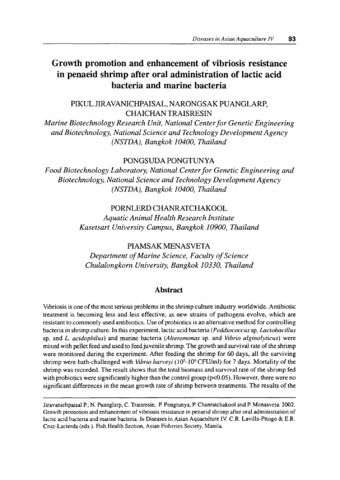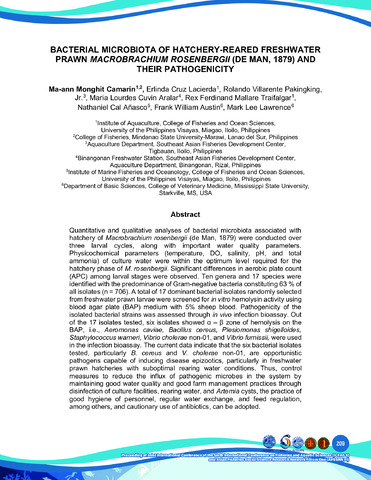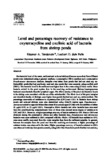Growth promotion and enhancement of vibriosis resistance in penaeid shrimp after oral administration of lactic acid bacteria and marine bacteria
- Global styles
- MLA
- Vancouver
- Elsevier - Harvard
- APA
- Help

View/
Date
2002Author
Page views
604AGROVOC keyword
Taxonomic term
Metadata
Perlihat publikasi penuh
Share
Abstract
Vibriosis is one of the most serious problems in the shrimp culture industry worldwide. Antibiotic treatment is becoming less and less effective, as new strains of pathogens evolve, which are resistant to commonly used antibiotics. Use of probiotics is an alternative method for controlling bacteria in shrimp culture. In this experiment, lactic acid bacteria (Peddiococcus sp, Lactobacillus sp, and L. acidophilus) and marine bacteria (Alteromonas sp. and Vibrio alginolyticus) were mixed with pellet feed and used to feed juvenile shrimp. The growth and survival rate of the shrimp were monitored during the experiment. After feeding the shrimp for 60 days, all the surviving shrimp were bath-challenged with Vibrio harveyi (105-106 CFU/ml) for 7 days. Mortality of the shrimp was recorded. The result shows that the total biomass and survival rate of the shrimp fed with probiotics were significantly higher than the control group (p<0.05). However, there were no significant differences in the mean growth rate of shrimp between treatments. The results of the challenge test shows that the groups fed with lactic acid bacteria had the highest survival rates (Peddiococcus sp., 86.4%; Lactobacillus sp., 90.5% and L. acidophilus, 93.8%), followed by the treatments fed with marine bacteria (Alteromonas sp, 74.6% and Vibrio alginolyticus, 61.8%) and the control treatment had the lowest survival rate (59%).
Suggested Citation
Jiravanichpaisal, P., Puanglarp, N., Traisresin, C., Pongtunya, P., Chanratchakool, P., & Menasveta, P. (2002). Growth promotion and enhancement of vibriosis resistance in penaeid shrimp after oral administration of lactic acid bacteria and marine bacteria. In C. R. Lavilla-Pitogo & E. R. Cruz-Lacierda (Eds.), Diseases in Asian aquaculture IV: Proceedings of the Fourth Symposium on Diseases in Asian Aquaculture, 22-26 November 1999, Cebu City, Philippines (pp. 93-103). Fish Health Section, Asian Fisheries Society.
Type
Conference paperISBN
9718020160Koleksi
Related items
Showing items related by title, author, creator and subject.
-
Bacterial microbiota of hatchery-reared freshwater prawn Macrobrachium rosenbergii (De Man, 1879) and their pathogenicity
Monghit-Camarin, Ma-ann ; Cruz-Lacierda, Erlinda R.; Pakingking, Rolando V., Jr.
; Cruz-Lacierda, Erlinda R.; Pakingking, Rolando V., Jr.  ; Cuvin-Aralar, Maria Lourdes
; Cuvin-Aralar, Maria Lourdes  ; Traifalgar, Rex Ferdinand
; Traifalgar, Rex Ferdinand  ; Añasco, Nathaniel C.; Austin, Frank William; Lawrence, Mark Lee (University of the Philippines Visayas, 2022)
Quantitative and qualitative analyses of bacterial microbiota associated with hatchery of Macrobrachium rosenbergii (de Man, 1879) were conducted over three larval cycles, along with important water quality parameters. ...
; Añasco, Nathaniel C.; Austin, Frank William; Lawrence, Mark Lee (University of the Philippines Visayas, 2022)
Quantitative and qualitative analyses of bacterial microbiota associated with hatchery of Macrobrachium rosenbergii (de Man, 1879) were conducted over three larval cycles, along with important water quality parameters. ... -
Efficiency of Chlorella sp. and Tilapia hornorum in controlling the growth of luminous bacteria in a simulated shrimp culture environment
This study clarifies the effect of green water from Chlorella sp., Tilapia hornorum and the combination of the two organisms on the growth of luminous bacteria in a simulated shrimp culture environment. Results showed that ... -
Level and percentage recovery of resistance to oxytetracycline and oxolinic acid of bacteria from shrimp ponds
The bacterial level of the water, sediment and cultured shrimp (Penaeus monodon) from different ponds were determined using a general medium, a presumptive Vibrio medium and a presumptive Pseudomonas–Aeromonas medium. ...





